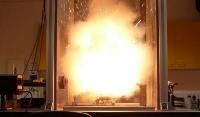Laser Technology Improves Solar Collectors
The sun is the energy source not only done for photovoltaic cells but also for thermal solar collectors. Whereas photovoltaic cells transform the sun's energy directly into electricity, solar collectors use a liquid which is heated by solar radiation. The thermal energy won during this process can be used for heating water in homes or in larger units for driving power generators.
In the heart of larger units are glass tubes filled with a liquid, which is heated by solar radiation. These glass tubes must be joined together, and according to the Laser Zentrum Hannover e.V. (LZH), laser technology is best suitable for this process. A new project between the LZH and several industrial partners aims at proving that laser joining of glass tubes has many advantages over the conventional flame method, and that it is more cost-efficient for the glass industry.
The disadvantages of the conventional flame technique can partly be compensated by trained staff, but it can also lead to product failure. During the joining process, impurities may occur in the joining zone, which cause considerable variations in the glass quality. Also, the heat input is difficult to regulate when using the flame technique. This is not the case with laser technology.
The advantages of laser joining of glass tubes are mainly temperature control, temperature distribution and in the automation. Additionally, in contrast to the flame joining, the laser joining technique prevents condensation and deposition in the glass tube, thus offering better quality. In combination with chemical resistant and robust borosilicate glass, breakage is significantly reduced, which in turn leads to a considerably lower reject rate.
The project "Lafuelsol" is funded by the German Federal Ministry of Education and Research (BMBF). The project organization is carried out by the Karlsruhe Institute of Technology, division Production and Manufacturing Technologies.
Organizations
Other news from the department science

Get the chemical industry in your inbox
By submitting this form you agree that LUMITOS AG will send you the newsletter(s) selected above by email. Your data will not be passed on to third parties. Your data will be stored and processed in accordance with our data protection regulations. LUMITOS may contact you by email for the purpose of advertising or market and opinion surveys. You can revoke your consent at any time without giving reasons to LUMITOS AG, Ernst-Augustin-Str. 2, 12489 Berlin, Germany or by e-mail at revoke@lumitos.com with effect for the future. In addition, each email contains a link to unsubscribe from the corresponding newsletter.



















































